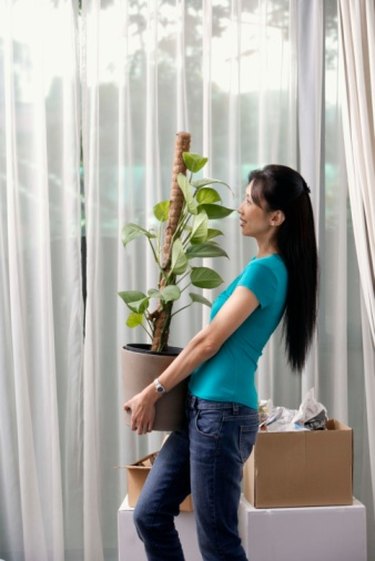
Indoor plants give off oxygen and add beauty to your home. Unfortunately, annoying flying insects also enjoy the moist conditions around houseplants and soil. Common flying insects that infest indoor plants include whiteflies, winged aphids and fungus gnats. Properly identifying the bugs flying around your indoor plants is the first step in getting rid of the annoying infestation.
Identification
Video of the Day
Whiteflies are relatives of mealybugs and scales, rather than true flies. At 1/16 inch long or less, they look similar to tiny, white moths. Aphids are about the same size as whiteflies. Although not all aphids have wings, some can fly near indoor plants. They have soft, pear-shaped bodies that are green or brown. Adult fungus gnats are grayish-black insects that are approximately 1/8-inch long with slender bodies similar to mosquitoes. They have a single pair of wings, long legs and antennae.
Video of the Day
Warnings
Although the insects are generally harmless to humans and pets, they damage some indoor plants. Fungus gnat larvae feed on the roots of houseplants. Small feeder roots and root hairs are most susceptible to damage. Aphids excrete honeydew, leaving the plant sticky and prone to mold. Both aphids and whiteflies feed on plant sap. The sap loss causes the plant to stop growing and lose leaves.
Prevention
Do not place cut flowers from your garden near houseplants because they often contain insects that travel to other plants. The most effective way to prevent gnats is to avoid overwatering your houseplants. Let the soil dry out as much as possible between watering. Larvae will die if the soil loses too much moisture. Be sure to use a flowerpot with holes in the bottom and a type of soil that drains well. Empty and dry the drip tray under your plant to further discourage flying insects. Wash your plant with water and let dry to discourage bugs from living on the leaves.
Solution
Use flying-insect traps to reduce the number of pests near houseplants. Hang a sticky trap near your houseplant and the bugs will land on the trap, get stuck and die. Although this kills many adult insects, it will not stop eggs and larvae from hatching. Use an indoor insecticide designed for your type of plant for severe infestations of aphids, whiteflies and fungus gnats. Carefully follow the instructions on the insecticide for proper application. Repeat treatment, as necessary.
- Ohio State University Extension; Fungus Gnats; William F. Lyon
- University of Kentucky College of Agriculture; Houseplant Insect Control; Lee Townsend
- PlantTalk Colorado; Fungus Gnats; October 2010
- Clemson University Cooperative Extension Service; Common Houseplant Insects & Related Pests; Janet McLeod Scott; December 2007
- Colorado State University Extension; Managing Houseplant Pests; W.S. Cranshaw; November 2010